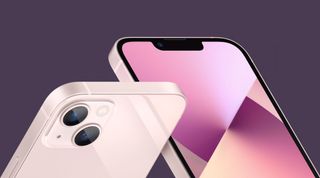The iPhone 13 and iPhone 13 mini are the most noticeable improvements here. Both feature a smaller notch at the top of the screen, repositioned rear-cameras, as well as far better performance. The notch is 20% smaller than previously which soon adds up. Paired up with that is a new Super Retina XDR display that’s 28% brighter courtesy of 1200 nits peak brightness. Both the iPhone 13 and iPhone 13 mini use a new A15 Bionic chip for processing which Apple reckons will offer a 50% faster CPU than the competition and 30% faster GPU. More interestingly perhaps is how the cameras have been improved. Both phones offer a new wide 12MP sensor that allows for 47% more light, and a 26mm focal length. Best of all is they also both offer the sensor-shift technology on the Ultra Wide lens that was previously only seen on the Pro range of iPhones. A new cinematic mode when taking video automatically blurs the background, allowing the subject to stay in focus with users able to switch to different subjects at a tap of the screen. The iPhone 13 mini will start at $699 with 128GB of base storage, while the iPhone 13 is priced from $799. Both are available to pre-order from Friday September 17 and will begin shipping September 24.
New iPhone 13 Pro and Max
Alternatively, there’s the iPhone 13 and iPhone 13 Pro Max which will be available at the same time. These offer Super Retina XDR displays with ProMotion technology, far better rear cameras, and a more powerful variant of the A15 Bionic chip. ProMotion means refresh rates of up to 120Hz as we’ve seen on many of the best smartphones (opens in new tab) including the iPhone 12 Pro range. The rear array of cameras contains new Telephoto, 77mm Ultra Wide, and Wide lenses with larger sensors and apertures, as well as sensor-shift stabilization for reduced camera shake. The iPhone 13 Pro also has a 6x optical zoom range thanks to its new 3x Telephoto camera while the Ultra Wide camera now has autofocus and a new macrophotography mode for taking close-ups up to 2cm away. The iPhone 13 Pro starts at $999 while the iPhone 13 Pro Max starts at $1,099.
New Apple Watch Series 7
The best smartwatches (opens in new tab) will undoubtedly see a shake up too with the Apple Watch Series 7 offering a new larger design and a new Retina display while still providing thinner borders. The watch will come in 41mm and 45mm size options and features a new casing that has a flat base and supposedly softer and more rounded corners. The screen also uses 50% stronger crack-resistant crystal for added durability. The always-on display promises to be brighter than ever before too. Alongside that, expect faster recharges with the watch charging up to 33% faster than previous models plus the ability to use a QWERTY keyboard interface on the larger screen. No word yet on a release date other than ’later this fall’ but the Apple Watch Series 7 will be available from $399.
Fresh iPad mini
There was also room for a couple of iPad announcements with the sixth generation iPad Mini the star of the show for the best tablets (opens in new tab). Offering a completely new design, it’s cut back on bezels and now offers an 8.3-inch display with the Home Button removed and a top button replacing it for Touch ID support. The display features wide color support, an antireflective coating, TrueTone functionality, plus 500 nits of brightness. In conjunction, the new iPad mini uses the A15 Bionic chip seen in the iPhone 13 range which means substantially improved performance for the small tablet. It’s also now available in a 5G variety if you opt for the cellular version, plus it supports the second-generation Apple Pencil. For those who take many video calls, the front camera has now been improved too with a new Ultra Wide front camera with a 12MP sensor and Center Stage support so the iPad mini will automatically keep users in the frame as they move around while on a call. The iPad mini starts at $499 and is available to pre-order now with orders shipping Friday 24 September. A new iPad was also announced but the changes are a little more subtle here. Starting at $329, the new iPad now utilizes the A13 Bionic chip, has an upgraded front camera like the iPad mini right down to Center Stage support, and its display now has TrueTone support so the tablet adjusts to the light you’re using it around. That’s about it for this fairly incremental update. So, it was a big day for Apple fans but we’re still hopeful to see new Macs and other possible refreshes later in the year. For now, new iPhones should appeal to anyone looking to upgrade their smartphone in the near future.
